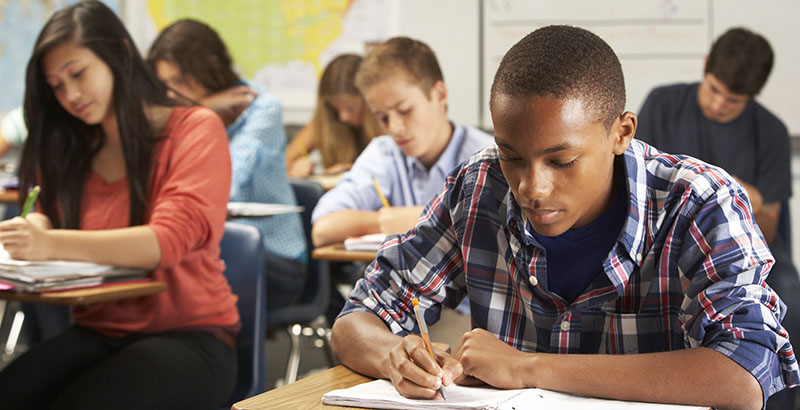Analysis — A Blueprint for Reopening America’s Schools This Fall: 21 Former Education Chiefs Identify 6 Top Priorities for Districts & Statehouses in Returning Amid Coronavirus

When schools reopen in the fall, they will look very different than the schools children left in the spring. There will likely be masks, temperature checks and extra space between desks. Nearly 1 out of 5 teachers may not be able to return to school buildings. And looming over schools will be the potential for additional closures forcing students back to remote learning.
Our nation’s education system faces an unprecedented challenge in redesigning itself to accommodate evolving guidance from public-health officials while serving the needs of every child. There are only four months to make the necessary preparations. Four months to rethink nearly every facet of education, from class schedules to instructional strategies. Four months to make sure there are enough laptops for students and professional development opportunities for teachers. Four months to use the crisis at hand to recommit to serving every student, but through new approaches.
The new Blueprint for Back to School lays out the issues leaders need to address in these next four months. It is a product reflecting the thinking of 21 former state education chiefs, federal policymakers (spanning the Clinton, Bush and Obama administrations), district superintendents and charter school leaders.
Because of the unique challenge of this moment, it is imperative that planning start now. School leaders face the challenge of making the necessary preparations amid so much uncertainty. Scientists are still trying to understand how COVID-19 spreads, why it has spread so quickly in some areas but not others, whether individuals can be reinfected, why many children seem surprisingly asymptomatic and which social distancing measures are most effective.
Schools won’t be able to wait for these answers. Instead, they need to develop adaptive plans based on different scenarios that can change as scientific consensus emerges. We can, however, make several initial assumptions based on the current guidance from public-health officials:
- It is likely that schools can reopen in the fall, but they need to plan for 14- to 28-day rolling closures triggered by local outbreaks.
- Reopened schools will need modifications based on guidance from health officials, which could include, among other things, physical distancing, temperature screenings and frequent disinfecting of classrooms.
- Accommodations will be needed for teachers, administrators, school staff and students who may be at heightened risk from COVID-19 due to their age or other health conditions.
- A vaccine might not be available for 18 months or more, which means we need to plan for these accommodations for not only the 2020-21 school year but also 2021-22.
Leaders will also need to rise to the challenge of finding ways to serve all students, even during times of disruption when remote learning requires them to connect from home. It’s not acceptable now, nor should it be for next year, for schools to say that because they could not provide education to all students, they cannot serve any.
The blueprint outlines six areas state policymakers and school leaders need to consider:
1 Coordination, communication and flexibility
Situations will vary profoundly across states and between different communities within the same state. States should consider launching a task force to develop recommendations for reopening their schools to ensure close cooperation and collaboration with local community leaders. Classrooms, hallways, school buses and other areas will need to undergo regular deep cleanings to minimize the spread of COVID-19. Additional regulatory flexibility may be needed to help schools procure needed resources. Policymakers will need to review state privacy statutes in light of new information-sharing requirements between schools and health officials. Schools should also review the privacy policies of their online content and service providers.
2 School operations
Schools will have to examine and adjust every aspect of the day — from classroom spaces to class schedules — to address new public-health guidance. For instance, they will need to devise plans that reflect physical distancing protocols, stagger class schedules or use temperature checks to screen students. Schools can also look to lessons learned from other countries. Germany, for example, is bringing some younger children to school but having older students continue to learn remotely. Israel reopened schools for special needs children while continuing remote learning for others.
3 Whole-child supports
Schools need to consider students’ social and emotional needs; some are going through significant trauma, having lost friends and family members or experienced insecurity after their parents lost their jobs. Students will have varying needs, and schools will need to identify ways of responding. Telehealth technologies offer the chance to expand counseling and other services.
4 School personnel
The federal Centers for Disease Control and Prevention and most public-health frameworks have suggested that vulnerable populations remain sheltered in place even if other parts of society reopen. This presents an enormous challenge for our education system, given that an estimated 18 percent of teachers and 27 percent of principals fall within the vulnerable age range. The number is likely higher when taking into account other school personnel such as cafeteria workers, bus drivers, custodians and administrators. Schools will need to think of creative ways of reassigning these educators, possibly to teach online or serve as virtual mentors for students. But states should also consider early retirement incentives and other certification reforms to recruit new teachers into school buildings. Districts and teachers unions should work together to revisit aspects of their labor agreements to help schools adapt new protocols and ensure that vulnerable teachers are able to work in ways that are safe and productive.
5 Academics
The current disruption to the school year has created broad academic challenges for students, particularly those who were most vulnerable before the crisis occurred. Schools may need to extend the traditional academic day or year to help students catch up on lost instruction. This is an opportunity to experiment with hybrid learning models that can extend the learning day through additional online coursework or lessons that a student can study after hours. It is also imperative that states commit now to administering their assessments in the spring of 2021. This will help identify students who need extra help and better target assistance to close equity gaps. Health officials believe we are likely to see additional waves of the coronavirus that could impact the coming academic years. Schools should prepare for possible intermittent closures next year and have a continuity-of-learning plan in place that serves all kids with online resources or printed materials that can be sent home.
6 Distance learning
The next few months offer the chance for schools to assess what did and didn’t work in an effort to develop better plans for the coming school year, including quality content and platforms to help manage classes remotely. It is also imperative for federal policymakers to provide funding to close the digital divide. We should commit to ensuring that all students, particularly those who are low-income and in rural areas, have the devices and connectivity they need to access learning.
These are daunting challenges in even the best of circumstances. But they can also serve as a catalyst for thinking about new ways of achieving traditional purposes. President Abraham Lincoln called for new thinking during another tumultuous period in our nation’s history: “The dogmas of the quiet past are inadequate to the stormy present. The occasion is piled high with difficulty, and we must rise — with the occasion. As our case is new, so we must think anew, and act anew.”
The COVID-19 crisis presents the chance to think and act anew as we design an education system that serves all students. We shouldn’t strive to return to “normal” but rather to attain something better. Even when schools were operating normally before COVID-19, many students were not being served well. The pandemic exposed the inequities that we have overlooked or ignored for too long.
Adapting to the challenges of COVID-19 gives America’s schools the opportunity to provide what is uniquely possible in the classroom while seeking new ways to fully use technology and community partnerships. There has never been a better time for schools to run their own pilots of blended learning, personalized learning and competency-based learning. Schools can meld the best of the brick-and-mortar experience of school with digital content, online courses and cloud-based services. Personalized learning could become the way we approach teaching and learning moving forward.
The good news is that parents want this. An Echelon Insights poll last week asked parents to choose between two visions of education post-coronavirus. Most parents (61 percent) agreed that “Schools should be focused on rethinking how we educate students, coming up with new ways to teach children moving forward as a result of the COVID-19 crisis.” Only 32 percent said schools should focus on trying to get back to the way things were done before COVID-19.
A generation of students is depending on us to get this right. As task force member Sharif El-Mekki, CEO of the Center for Black Educator Development, pointed out, “Not being prepared to close suddenly is understandable; we were all caught off guard. But being unprepared to reopen and support students in the new normal won’t be. The old adage applies: Those who fail to plan, plan to fail.”
It’s time to act anew.
John Bailey is an adviser to the Walton Family Foundation and a visiting fellow at the American Enterprise Institute. He previously served in the White House and U.S. Department of Education. He worked on pandemic preparedness at the U.S. Department of Commerce in 2006.
Disclosure: The Walton Family Foundation provides financial support to The 74.
Get stories like these delivered straight to your inbox. Sign up for The 74 Newsletter

;)
